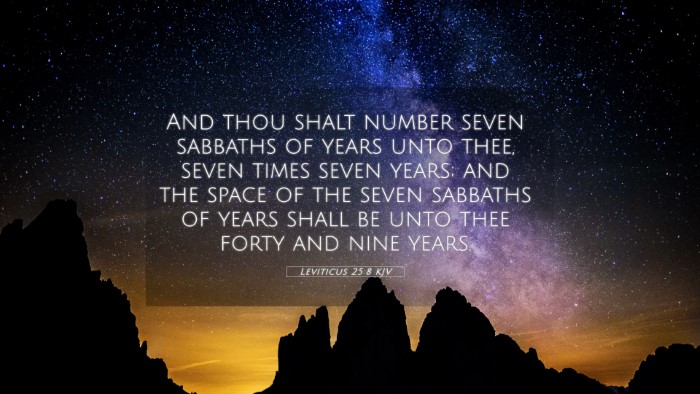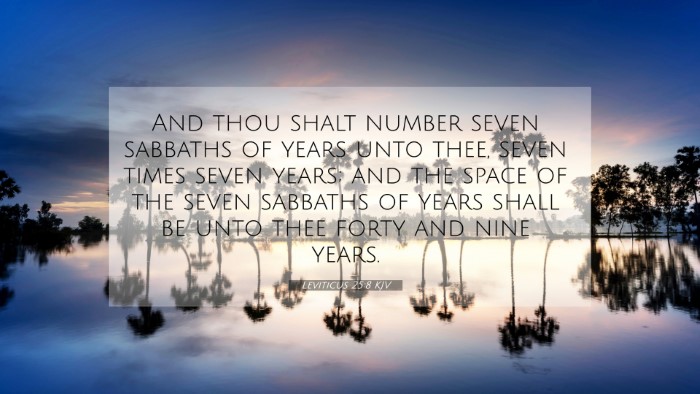Understanding Leviticus 25:8
The verse Leviticus 25:8 states:
"And thou shalt number seven sabbaths of years unto thee, seven times seven years; and the space of the seven sabbaths of years shall be unto thee forty and nine years."
Meaning and Interpretation
This verse is part of the instructions given to the Israelites regarding the Jubilee year, which emphasizes the importance of rest, redemption, and restoration. The counting of seven sabbaths of years signifies a structured approach to time and God's ordained rhythm for His people.
Key Insights from Public Domain Commentaries
-
Matthew Henry:
Henry emphasizes the significance of periodical rest and the liberation associated with the Jubilee year. By establishing a cycle of seven years, the Israelites had a rhythmic reminder of God’s provision and the necessity of both work and rest.
-
Albert Barnes:
Barnes points out that the number seven is biblically significant, representing completeness and perfection. This command was instructing the Israelites to recognize the completion of time before God, facilitating both economic justice and spiritual renewal.
-
Adam Clarke:
Clarke illustrates that this command was not merely administrative but deeply theological. It indicates God’s control over history and humanity's need to rely on divine timing, instilling a sense of hope and community.
Significance of the Seven-Year Cycle
The seven-year cycle has profound implications:
- Rest for the land: Just as every seventh day was to be a Sabbath for the Israelites, so too were the land's crops to have a year of rest.
- Restoration: The Jubilee year was a time to restore possessions and liberate those who had sold themselves into servitude, emphasizing the concept of redemption.
- Community cohesion: The returning of lands and property served to strengthen community ties and societal equity.
Cross-References to Leviticus 25:8
To enrich our understanding of Leviticus 25:8, we can examine several Bible verse cross-references that touch on similar themes:
- Exodus 23:10-11: Discusses the need for the land to rest every seventh year.
- Deuteronomy 15:1-2: Expounds on the release of debts every seven years, emphasizing mercy and justice.
- Isaiah 61:1-2: Prophesies the “acceptable year of the Lord,” often related to the Jubilee.
- Luke 4:18-19: Jesus’ declaration of the Jubilee Spirit, calling for liberation and restoration.
- Matthew 18:21-22: Jesus speaks about forgiveness, reflecting the heart of the Jubilee message.
- Leviticus 25:10: Directly follows and explains the consequence of the Jubilee year.
- Proverbs 3:9-10: Encourages honoring God with resources, reinforcing the importance of stewardship.
Connection to New Testament Teachings
The Jubilee concept has connections throughout Biblical narrative, especially in the teachings of Jesus and the Apostles. These connections illustrate the continuity of God's redemptive plan:
-
Thematic Bible verse connections:
The motifs of rest and redemption in the Old Testament are reflected in the New Testament teachings of grace and salvation.
-
Inter-Biblical dialogue:
The prophets often spoke about restoration themes that echo the principles established in Leviticus 25.
-
Scriptural cross-referencing:
Insights from passages in the Gospels and Epistles can elucidate the continued relevance of these laws in the Christian faith.
Tools for Bible Cross-Referencing
Utilizing a Bible concordance or a Bible cross-reference guide can greatly enhance your study:
- How to use Bible cross-references: Learning to identify relevant connections can deepen your understanding of scripture.
- Cross-referencing Bible study methods: There are various approaches to study that can help you link verses meaningfully.
- Bible reference resources: Consider utilizing tools that provide comprehensive cross-reference materials for deeper study.
Conclusion
Leviticus 25:8 serves as a vital reminder of God's principles regarding time, rest, and restoration. The interconnectedness of this verse with various other scriptures highlights the rich tapestry of Biblical teaching and the overarching themes of redemption and community. As we explore these connections through careful study and cross-referencing, we gain a more profound appreciation of God's word.




